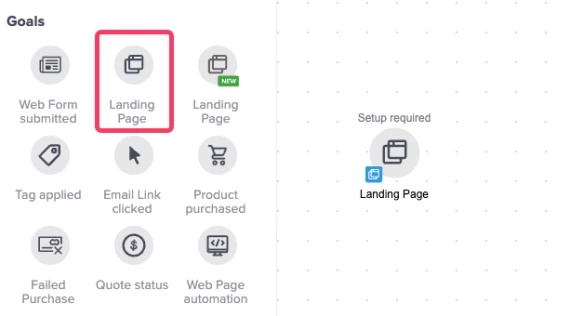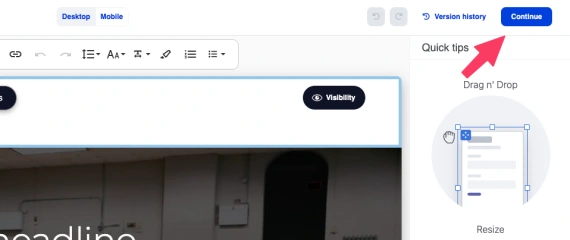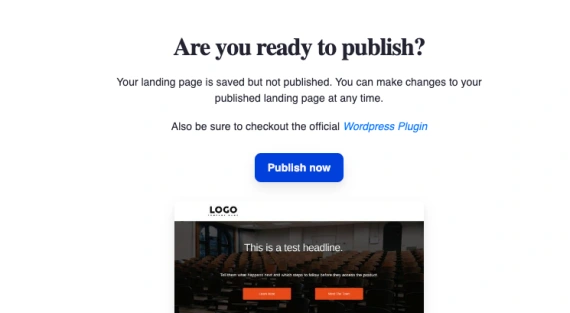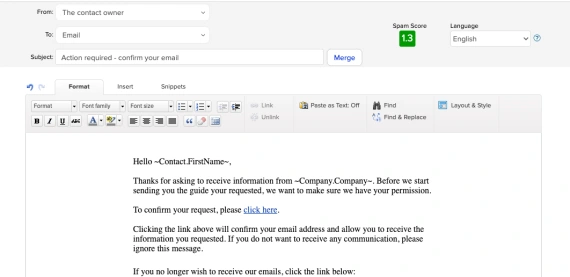One of the most important aspects of a successful marketing campaign is a landing page to capture your audience’s interest and drive revenue. While they’re incredibly important, landing pages can be overwhelming for small business teams.
But with business automation software like Keap, creating landing pages can be quick and easy. In this guide, we'll walk you through the key steps so you can create a conversion-ready page in less than a half hour.
Why use landing pages?
The connective tissue between reaching an audience and converting them occurs on a dedicated page known as a landing page. These pages turn lifecycle automation (aka lifecycle marketing) from theory to application by:
- Attracting a qualified audience
- Building interest in your offer
- Capturing lead information by using web forms
The most common outcome of a landing page is to direct qualified leads to be added to your small business CRM, so you can educate and drive revenue through follow-up campaigns.
Landing pages should receive frequent updates to improve their messaging and approach. A landing page gives you the ability to get a specific message seen and considered by a specific audience. And the more you experiment with landing pages, the better your chances of grabbing your prospects' attention.
Typically, traffic directed to a landing page isn't free. Paid ads across Google, Meta, LinkedIn, or X aren't free, so it's essential your landing page delivers on its purpose: convert visitors into prospects.
Conversion optimization is mission-critical. It's the difference between a stab in the dark and a methodical process to maximize demand and attain revenue. It's the secret sauce behind the world's most profitable marketing campaigns.
Did you know? Long landing pages can generate up to 220% more leads than short-form, above-the-fold CTAs. This research from MECLABS implies the value of comprehensive information in conversions. Users prefer to learn more about a product or service before making a purchase decision.
Five easy steps to create effective landing pages in Keap
The process of crafting effective landing pages within Keap doesn't have to be overwhelming. In fact, you could have it up and running in just 20 minutes or less.
Step 1: Establish your goal (5 minutes)
Your first task is to clearly define the purpose of your landing page. What action do you want the visitor to take? It could be anything from subscribing to a newsletter to purchasing a product. Keep this objective in mind throughout your building process.
My advice is to not overthink it. Meet your audience at their level of interest and pain points.
Here are five types of landing pages businesses should create:
- Event registration: Best for time-bound events like webinars, conferences, and meetups
- Sales demos: Overcome objections tactfully and highlight the value most people miss
- Free consultations: Build value and qualify leads by leading with a plan and objective recommendations
- Customer onboarding: Understand more about your customers right after they convert
- Competitor versus pages: Articulate the advantages your service or product has over known competitors
For more direction on improving an existing page, read my guide explaining how to optimize your landing pages on the Convrrt blog.
Step 2: Choose a template (2 minutes)
Keap provides a host of pre-designed landing page templates that are optimized for conversion. Choose one that aligns best with your goal. Remember, it should flow logically and be visually attractive to ensure visitors stay engaged.
The old way: Hire a graphic designer to help take your copy ideas and come back with a few options. Go back and forth over a few weeks to settle on the final direction of your page layout.
The new way: Choose from 70+ proven landing page templates with the Convrrt Page Builder. These already have a conversion-ready layout and include sample copy you can use for inspiration.
To access these templates, simply open up the Keap Automation Builder and add a landing page to the canvas.


Add landing pages by dragging the Landing Page goal onto the Automation Builder canvas. Then double-click the goal, and click “Create a landing page” to choose a template.
Step 3: Customize the template (8 min)
With a solid idea in mind, you should now be able to tailor the page to fit your objectives. Half of the work has already been done for you! The landing pages included with Keap are optimized to convert visitors into leads and customers.
Here are several helpful pointers:
- Don't over-explain your offer. Keep your messaging concise and clear. Too much information can drown out your call to action and confuse your audience.
- Meet your audience at their level of interest. Understanding the needs and desires of your potential visitors is key to ensuring your messages stick. Matching the interest level of your audience drives better conversion rates. Remember, you will have a follow-up campaign set up afterward.
- Include your phone number. For some services, prospects will want to talk to someone right away instead of completing a form. Include your business phone number in the header and within the content to invite those opportunities. You'd be surprised by the response rates here, so don't overlook it.
- Create an incentive to act now. Urgency is a must on a landing page because visitors are unlikely to come back again once they arrive. Give them an irresistible reason to exchange their contact information in the moment.
- Only include the necessary content: Stay focused. Unnecessary content confuses your visitors and drives them away, rather than encouraging them to take action. Be intentional with every word, image, and element you incorporate, making sure each one serves a role in convincing visitors to convert.
Setting up your web form is simple — simply choose which fields you want to collect. We recommend adjusting the CTA button text so it's action-oriented versus a dull "Submit." This way, visitors know what to expect when they click on it.
Save time by setting your brand's typography and colors in the page settings. It will update the colors and fonts automatically throughout the page and still allow further customization.
Step 4: Test and publish the page (0 min)
When you're confident that you have a compelling landing page, the next step is to publish the page so you can share it and people can access it. With Keap, you have plenty of options, but to get there, click Continue at the top right corner.


Once you click Publish now, you can always access your landing page at the URL shown below the thumbnail.
We recommend setting up a custom domain so it's hosted on your company's website. Something like "pages.domain.com" or "go.domain.com" is best practice for making your landing pages look great, building trust, and capturing even more leads.
Alternatively, you can embed the landing page on another page. You can copy the embed code and add it to an existing page, and it will replace the content with your landing page.
Step 5: Configure the follow-up sequence (5 minutes)
After visitors complete your landing page, you need to provide them with the goods. Following through on your offer is essential to building trust and collecting revenue later.
It's a good idea to strike when the iron is hot and ask newly converted visitors to confirm their email addresses. The email confirmation sequence is a straightforward way to do this. Doing so will improve your email reputation and filter out lower-quality leads that really weren't interested in the first place.

The follow-up campaign could be easily triggered by adding a tag if you didn't want to make the campaign exclusively tied to the landing page itself or another method of business automation with Keap.
Once you wire up your follow-up sequence, be sure to toggle your emails from "Draft" to "Ready" and hit publish!

Speed matters when creating landing pages
I want to explain, for a moment, the high-level approach to creating landing pages. A lot of businesses tend to focus their energy on one page. This is a miss because not every offer or audience segment can be addressed on one landing page.
Validating distinct marketing messages
The antidote to a lackluster marketing campaign is to create several landing pages. These are calculated "bets" that you can bank on to get in front of your audience and engage them with a captivating offer.
Let me illustrate an example of the impact here. Say you created eight landing pages, four of which performed well. You’ve now tripled your performance from only using one landing page.
Diversifying your offers helps you reach your target market.
For instance, if you want to sell a service to a doctor's office, you most likely aren't selling to the doctor directly. In reality, you're really trying to sell to the office manager. They’re the ones who make recommendations and champion your solution to the decision-makers. But what if you could reach different audiences, such as insurers, physician assistants, medical billing managers, and so on?
Many small businesses aren't afforded the privilege of spending weeks or hundreds of dollars to create each page. It's just not sustainable.
Developing effective pages at scale
You've got to make the time you spend creating landing pages count. Developing landing pages in minutes versus weeks is key to scaling your business.
By quickly creating distinct approaches to your audience, messaging, and offers, you can get the feedback you need to improve your campaigns. Rather than completely revising the entire page, focus on the distinct elements of the landing page.
You could duplicate pages and modify a few elements.
- Headlines
- Audiences
- Content (long vs. short)
- Offer
The strategy isn't to spend a ton of resources here, but to move fast.
Ensure your online ads have some congruency in the headline, audience, and offer to match your landing page. With that in mind, it's a surefire strategy to capture more leads and drive more sales.
One landing page alone can't appeal to everyone, but several could. And the faster you can ship these, the more likely you are to achieve your business growth goals. Keap lets you create as many landing pages as you need, so you can discover the one that works best.
Landing pages are just the beginning
Creating conversion-optimized landing pages efficiently is a must for every small business owner, so they can compete and win in the marketplace.
Traditionally, creating landing pages is an arduous task, even with the WordPress platform powering about 40% of the web.
This is where Keap shines. As a highly rated small business CRM, it includes the flexibility to create landing pages natively integrated with its CRM, e-commerce, and marketing functions. In other words, there are no hassles trying to connect two different platforms — it just works.
Keap also offers comprehensive business automation capabilities, allowing teams to set up workflows that streamline their processes and increase productivity. Imagine the possibilities when you can streamline client onboarding, drive customer referrals, and scale your demand generation. It's all possible with Keap.
Try Keap for free for 14 days, or schedule a product demo with an expert to see how your business can work smarter and grow faster
About Kavin Patel
Kavin Patel is the CEO and co-founder of Convrrt, a landing page platform that helps SaaS businesses scale faster. He has over 19 years of experience in the tech industry and is a trusted advisor in demand generation and customer success. Kavin is an Economics major from Arizona State University and uses his analytical and creative skills to solve growth challenges. He was previously the principal at Omazing Creations, where he discovered the opportunity to simplify landing page publishing for thousands of businesses. In his free time, Kavin enjoys spending time with his family and traveling the world.


